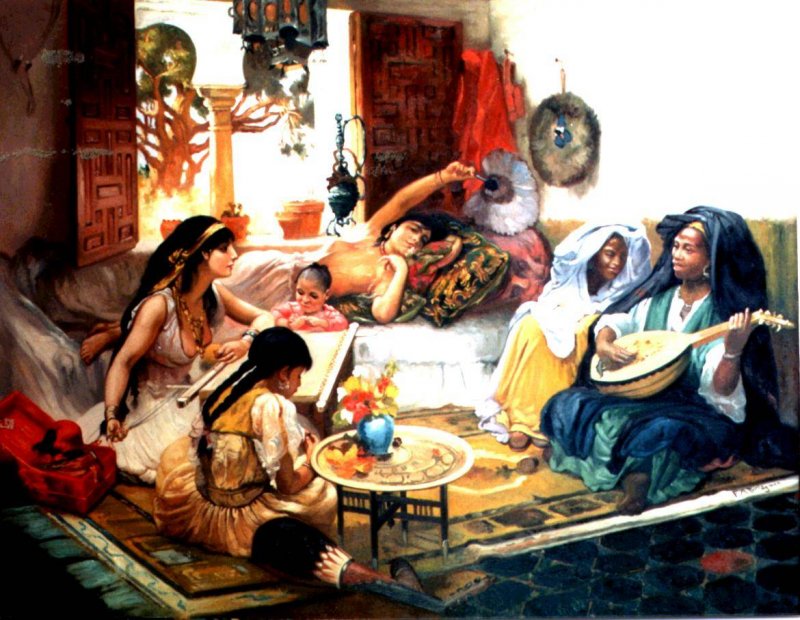The sexual fantasies in the Arab collective imaginary have went undergone various transformations since pre-Islamic times until the modern era. Images of wide-eyed nymphs no longer excite the imagination of youths who settle before their computer screens, surfing the internet. [h2]Before Islam[/h2] In the era before the advent of Islam, the desert dictated the Arabs’ sexual fantasies. Poems by Imru’ al-Qais and Antarah ibn Shaddad were extremely popular, in which women were commonly compared to antelopes, swords, stars, and the moon, as the the desert itself was the catalyst for the imagination and the rouser of passions. Even the shine of their swords served as a stimulus for their sensuous imaginations. "I wished to kiss the swords, for verily they shone as bright as the flash of the foretooth of your smiling mouth," Antarah wrote in one poem. In his encyclopaedic text, Kitābʿuyūn al-akhbār (The Book of Choice Narratives), Ibn Qutaybah wrote about a man who asked a Bedouin: “What is fornication to you? He answered: A kiss and a hug. The other man responded and said: This is not fornication to us. The Bedouin said: What then? The man responded: It is when a man sets between a woman's four limbs until he exhausts himself. The Bedouin then said: This is not fornication, but rather a man seeking a child.” From this passage, we can deduce that this understanding of fornication was widespread in certain Arab circles, and continued to exist even after the advent of Islam. Arabs in pre-Islamic times had sexual beliefs pertaining to certain days and months. They favored sexual intercourse on Fridays, and despised it during the month of Shawwal. However, with the arrival of Islam, many of the prevailing Arab customs were eradicated. The Prophet Muhammad deliberately established customs that were contrary to the old traditions. For instance, he married Aisha in Shawwal. [h2]After Islam[/h2] Some verses of the Quran reflected certain pre-Islamic Arab fantasies. Based on Taha Hussein's theories in his On Pre-Islamic Poetry, the Quran can be viewed as the most accurate documentation of the lives of pre-Islamic Arabs. Thus, the descriptions of women in the promised paradise exemplified the fantasies of Arabs during the time Muhammad delivered his message. The Quran describes these paradise companions as gazelle-eyed houris; virgins with strikingly kohled eyes. It was said that, in heaven, a man would have intercourse with one of these women, and her virginity would be restored again thereafter. The Umayyads were not very different from their predecessors in their fantasies. Moving to the Abbasid era, there emerges an infatuation with pubescent boys. Pioneering this trend was Abu Nawas, whose poetry manifested the fantasies of certain princes and members the public sphere. In his discussions of promiscuity in the Abbasid era in Wednesday Talk, Taha Hussein notes that Abu Nawas captured the imaginations of the people of Baghdad, the capital of the Abbasid state, as well as Iraq, Egypt and the Levant. He recounts that they memorized his poems, told stories about him, and invented chronicles of his life. Thus, Hussein concludes that Abu Nawas was, by wide consensus, the authentic spokesperson of the era. Moreover, in Lectures by the Literati, Al-Raghib al-Isfahani recalls that Abu Muslim al-Khorasani was asked: what are the pleasures of life? He answered: “Plentiful food, yellow liquor, and a dark-eyed youth.” When asked why he chose a boy over a girl, he responded that a boy does not menstruate. Regarding his preference for boys over women, the Abbasid poet said that boys do not menstruate, nor do they get pregnant. [h2]The Characteristics of a Seductress[/h2] The narratives of Arab heritage are rich in detailed description of the ideal woman. A passage from Muḥammad ibn Muḥammad al-Nafzawi’s The Perfumed Garden of Sensual Delight summarizes the descriptions of the kind of woman who tickled the fancies of our Arab ancestors. This ideal woman was described as follows: “In order that a woman may be relished by men, she must have a perfect waist, and must be plump and lusty. Her hair will be black, her forehead wide, she will have eyebrows of Ethiopian blackness, large black eyes, with the whites in them very limpid. With cheeks of a perfect oval, she will have an elegant nose and a graceful mouth; lips and tongue vermillion; her breath will be of pleasant odour, her throat long, her neck strong, her bust and her belly large; her breasts must be full and firm; her belly in good proportion, and her navel well-developed and marked; the lower part of the belly is to be large, the vulva projecting and fleshy from the point where the hairs grow to the buttocks; the conduit must be narrow and not moist, soft to the touch, and emitting a strong heat and no bad smell; she must have the thighs and buttocks hard, the hips large and full, a waist of fine shape, hands and feet of striking elegance, plump arms and well-developed shoulders.” [h2]Medical Beliefs and Myths[/h2] At the time, the prevailing medical practices gave birth to particular fantasies and sexual habits. Arabs believed that the characteristics of the beloved ones were dictated by certain ailments, and that the times of day impacted the practice of sexual intercourse. For example, some believed that intercourse with beautiful, desirable women had a positive impact on personal health, and the opposite was also true. Ibn Qayyim al-Jawziyya wrote, in The Prophetic Medicine, that making love to the beloved mitigates the weakening of body upon ejaculation, while intercourse with unattractive women was believed to deteriorate the body. Furthermore, the tales of One Thousand and One Nights, which date back to the year 1500, reflect the sexual fantasies in the Arab world between the late Abbasid period and the beginnings of the Fatimid state. We read that the women were fond of youths, especially black ones. The stories depict women who sought sex with beggars. Moreover, there were stories of lesbian encounters and bestiality. In tale of Wardan the Butcher, which can best be described as a tale of magical realism, we read that a woman visited a butcher everyday to buy meat. The butcher became suspicious and followed her, only to find she was keeping a bear in hiding, which she fed and engaged in intercourse with. He slaughtered the bear and advised the woman to seek repentance. Moreover, throughout the One Thousand and One Nights, women are depicted as dominant, lustful, and adulterous. [h2]Sexual Fantasy in Modern Times[/h2] The emergence of cinema in the 20th century resulted in a significant shift in the sexual imaginations of Arabs. They fantasized about movie stars. Men became preoccupied with actresses like Hind Rustom, Naima Akef, Sabah, Nadia El-Guindi, and Nabila Obeid, among others. Dancers, singers, and actresses inspired men's fantasies. With the prevalence of foreign films in the 1970s, and the emergence of video and the Internet, men began to develop a penchant for “Western” ideals of beauty. Similarly, Western features excited the desires of Arab women. Actors such as Hussein Fahmi, with blond hair and green eyes, captured the fancy of many girls and women in the ‘70s and ‘80s. Among the statistics providing detailed data on the impact of pornography on sexual fantasy is the study prepared by the Journal of Sex Research, which was conducted on 73 Swedish men. The study indicates that pornographic films reflects a masculinist hegemony in sexual practices, as men are perceived as the active agents, while women are deemed submissive—existing purely to fulfill the desires of males. In the same study, women admitted comparing their bodies to those of porn stars, and expressing anxieties over their own bodies, as well as fears of being found insufficiently attractive to their sexual partners. There is no doubt that pornography currently has an enormous influence on the sexual fantasies of Arabs. In 2012, five porn sites were ranked among the top 100 most browsed websites by Egyptians, according to Alexa. In the same year, statistics also showed that the UAE, Egypt, Saudi Arabia, Bahrain, Kuwait, and Qatar residents topped the lists of the most frequent visitors of porn websites.
Raseef22 is a not for profit entity. Our focus is on quality journalism. Every contribution to the NasRaseef membership goes directly towards journalism production. We stand independent, not accepting corporate sponsorships, sponsored content or political funding.
Support our mission to keep Raseef22 available to all readers by clicking here!
Interested in writing with us? Check our pitch process here!



